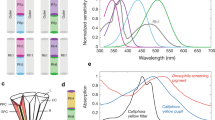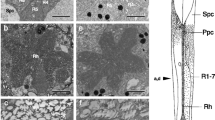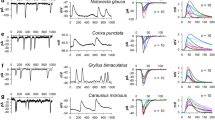Summary
Intense short wavelength adaptation converts rhodopsin to a long wavelength absorbing stable metarhodopsin and inactivates R1–6 photoreceptors inDrosophila. In addition to decreasing sensitivity, vitamin A deprivation eliminates this short wavelength induced R1–6 inactivation. A model (Fig. 4) explains this adaptational difference of vitamin A deprivedDrosophila (from normally-reared or high vitamin A supplemented flies) in terms of decreasing photopigment quantity without decreasing membrane adaptation mediating channels. The data and model suggest that 1) photopigment and membrane processes are separate; 2) transduction and adaptational mechanisms are different; and 3) maximal adaptation establishes a steadystate wavelength-specific rhodopsin to metarhodopsin ratio. Sensitivity as a function of wavelength for maximal adapting stimuli was obtained from vitamin A deprivedDrosophila (Fig. 3). These data reflect relative rhodopsin levels. They were used to derive a measure related to spectral sensitivity ofin vivo metarhodopsin spectral absorption characteristics (Fig. 5). The presently reported metarhodopsin spectral function has certain advantages over previously reported electrophysiologically-based functions. It differs fromin vitro data by having an ultraviolet maximum and a shorter wavelength visible maximum. This finding is consistent with current theory on fly vision. The data obtained from vitamin A deprivedDrosophila are similar to data fromCalliphora andMusca; possible adaptational differences among different fly species may be explained by the model which explains differences betweenDrosophila in the vitamin A deprived vs. enriched conditions.
Similar content being viewed by others
References
Cosens, D., Wright, R.: Light elicited isolation of the complementary visual input systems in white-eyeDrosophila. J. Insect Physiol.21, 1111–1120 (1975)
Doane, W.W.: Drosophila. In: Methods in developmental biology (ed. F.H. Wilt, N.K. Wessels). New York: Thomas Y. Crowell Co. 1967
Fein, A., Cone, R.A.:Limulus rhodopsin: rapid return of transient intermediates to the thermally stable state. Science182, 495–497 (1973)
Fein, A., DeVoe, R.D.: Adaptation in the ventral eye ofLimulus is functionally independent of the photochemical cycle, membrane potential, and membrane resistance. J. gen. Physiol.61, 273–289 (1973)
Fein, A., Lisman, J.: Localized desensitization ofLimulus photoreceptors produced by light or intracellular calcium ion injection. Science187, 1094–1095 (1975)
Goldsmith, T.H., Barker, R.J., Cohen, C.F.: Sensitivity of visual receptors of carotenoid-depleted flies: a vitamin A deficiency in an invertebrate. Science146, 65–67 (1964)
Goldsmith, T.H., Bernard, G.D.: The visual system of insects. In: Physiology of insecta, vol. II, 2nd ed. (ed. M. Rockstein). New York: Academic Press 1974
Goldsmith, T.H., Fernandez, H.R.: Some photochemical and physiological aspects of visual excitation in compound eyes. In: The functional organization of the compound eye (ed. C.G. Bernhard). Oxford-New York: Pergamon Press 1966
Hamdorf, K., Paulsen, R., Schwemer, J.: Photoregeneration and sensitivity control of photoreceptors of invertebrates. In: Biochemistry and physiology of visual pigments (ed. H. Langer). Berlin-Heidelberg-New York: Springer 1973
Hamdorf, K., Rosner, G.: Adaptation und Photoregeneration im Fliegenauge. J. comp. Physiol.86, 281–292 (1973)
Harris, W.A., Stark, W.S., Walker, J.A.: Genetic dissection of the photoreceptor system in the compound eye ofDrosophila melanogaster. J. Physiol. (Lond.), in press (1976)
Horridge, G.A., Mimura, K.: Fly photoreceptors I. Physical separation of two visual pigments inCalliphora retinula cells 1–6. Proc. roy. Soc. B190, 211–224 (1975)
Lindsley, D.L., Grell, E.H.: Genetic variations ofDrosophila melanogaster. Oak Ridge. Tennessee: Oak Ridge National Laboratory 1968
Lisman, J.E., Brown, J.E.: The effects of intracellular iontophoretic injection of calcium and sodium ions on the light response ofLimulus ventral photoreceptors. J. gen. Physiol.59, 701–719 (1972)
Minke, B., Hochstein, S., Hillman, P.: Antagonistic process as source of visible-light suppression of afterpotential inLimulus uv photoreceptors. J. gen. Physiol.62, 787–791 (1973)
Minke, B., Wu, C.-F., Pak, W.L.: Isolation of light induced response of the central retinula cells from the electroretinogram ofDrosophila. J. comp. Physiol.98, 345–355 (1975)
Muijser, H., Leutscher-Hazelhoff, J.T., Stavenga, D.G., Kuiper, J.W.: Photopigment conversions expressed in receptor potential and membrane resistance of blowfly visual sense cells. Nature (Lond.)254, 520–522 (1975)
Ostroy, S.E., Wilson, M., Pak, W.L.:Drosophila rhodopsin: photochemistry, extraction and differences in the norp AP12 phototransduction mutant. Biochem. biophys. Res. Commun.59, 960–966 (1974)
Pak, W.L., Lidington, K.J.: Fast electrical potential from a long lived, long-wavelength photoproduct of fly visual pigment. J. gen. Physiol.63, 740–756 (1974)
Snyder, A.W., Pask, C.: Spectral sensitivity of dipteran retinula cells. J. comp. Physiol.84, 59–76 (1973)
Stark, W.S.: Spectral selectivity of visual response alterations mediated by interconversions of native and intermediate photopigments inDrosophila. J. comp. Physiol.96, 343–356 (1975)
Stark, W.S., Pransky, G.S., Zitzmann, W.G.: Separation of photopigment from membrane adaptation by vitamin A deprivation in theDrosophila retina. In: Society for Neuroscience Program and Abstracts (1975), (abstract)
Stavenga, D.G.: Dark regeneration of invertebrate visual pigments. In: Photoreceptor optics (ed. A.W. Snyder, R. Menzel). Berlin-Heidelberg-New York: Springer 1975
Stavenga, D.G., Zantema, A., Kuiper, J.W.: Rhodopsin processes and the function of the pupil mechanism in flies. In: Biochemistry and physiology of visual pigments (ed. H. Langer). Berlin-Heidelberg-New York: Springer 1973
Wasserman, G.S.: Invertebrate color vision and the tuned receptor paradigm. Science180, 268–275 (1973)
Zimmerman, W.F., Goldsmith, T.H.: Photosensitivity of the circadian rhythm and of visual receptors in carotenoid-depletedDrosophila. Science171, 1167–1169 (1971)
Author information
Authors and Affiliations
Additional information
Supported by NSF Grant BMS74-12817 and Johns Hopkins Biomedical Sciences Research award from NIH 3-SO5-RR07041-08S1 to W. S. S. We thank William Sofer, Glenn Pransky and Austina Ivanyshyn for advise and technical assistance and John Walker, William Sofer and Elliott Blass for criticisms on the manuscript.
Rights and permissions
About this article
Cite this article
Stark, W.S., Zitzmann, W.G. Isolation of adaptation mechanisms and photopigment spectra by vitamin A deprivation inDrosophila . J. Comp. Physiol. 105, 15–27 (1976). https://doi.org/10.1007/BF01380050
Received:
Issue Date:
DOI: https://doi.org/10.1007/BF01380050




